Chukadon or Chinese-style Rice Bowl is chock-full of stir-fried seafood, meat, and vegetables. Cooked in a soy-infused sauce, this recipe has all the flavors of your favorite takeout!
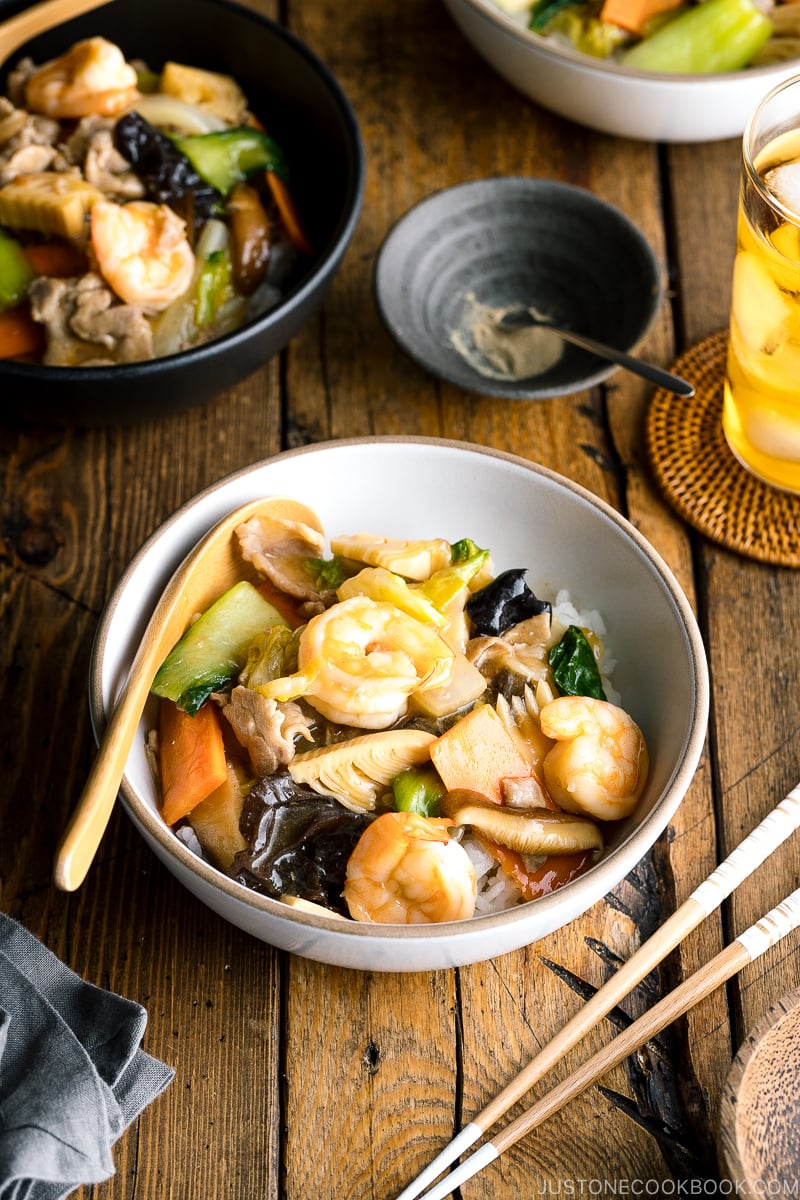
Chukadon (中華丼) is one of those dishes that provide both comfort and satisfaction at the end of a long day. Flashed cooked in a wok and served over a bowl of steamed rice, it meets my hallmarks of ‘easy cleanup’ and ‘one-pot favorites.’
What is Chukadon
Chukadon (中華丼) literally means “Chinese style Rice Bowl” in Japanese. It’s a donburi (don for short) that consists of stir-fried ingredients served over rice. It is believed that chukadon originated in the 1930s from a Chinese-style restaurant in Tokyo.
The colorful stir-fry that sits atop of the rice is actually a well-known dish itself and it’s called Happosai (八宝菜) in Japanese. It came from the Cantonese “Eight Treasure” (八宝) dish.
Happosai served over steamed rice is called Chukadon, and when it’s served over crispy noodles, we call it Ankake Yakisoba or Gomoku Yakisoba, similar to Sara Udon.
The number from “Eight Treasure” doesn’t necessarily mean the dish contains 8 ingredients. It just implies an abundance of ingredients from seafood (shrimp and squid) to meat (typically pork), to sliced vegetables that are all stir-fried quickly in a wok (or pan).
Happosai (Japanese-style Eight Treasure) is mainly seasoned with both soy sauce and oyster sauce, along with additional and optional condiments. To finish, slurry sauce (starch and water) is added to create a thick saucy dish that goes perfectly over steamed rice. When the stir fry is thickened, we call the dish Ankake (あんかけ) in Japanese.
Not only Chukadon can employ a variety of nutritioius ingredients, it’s one of popular fast foods at Japanese fast food diners. Today let’s make it in our own kitchen!
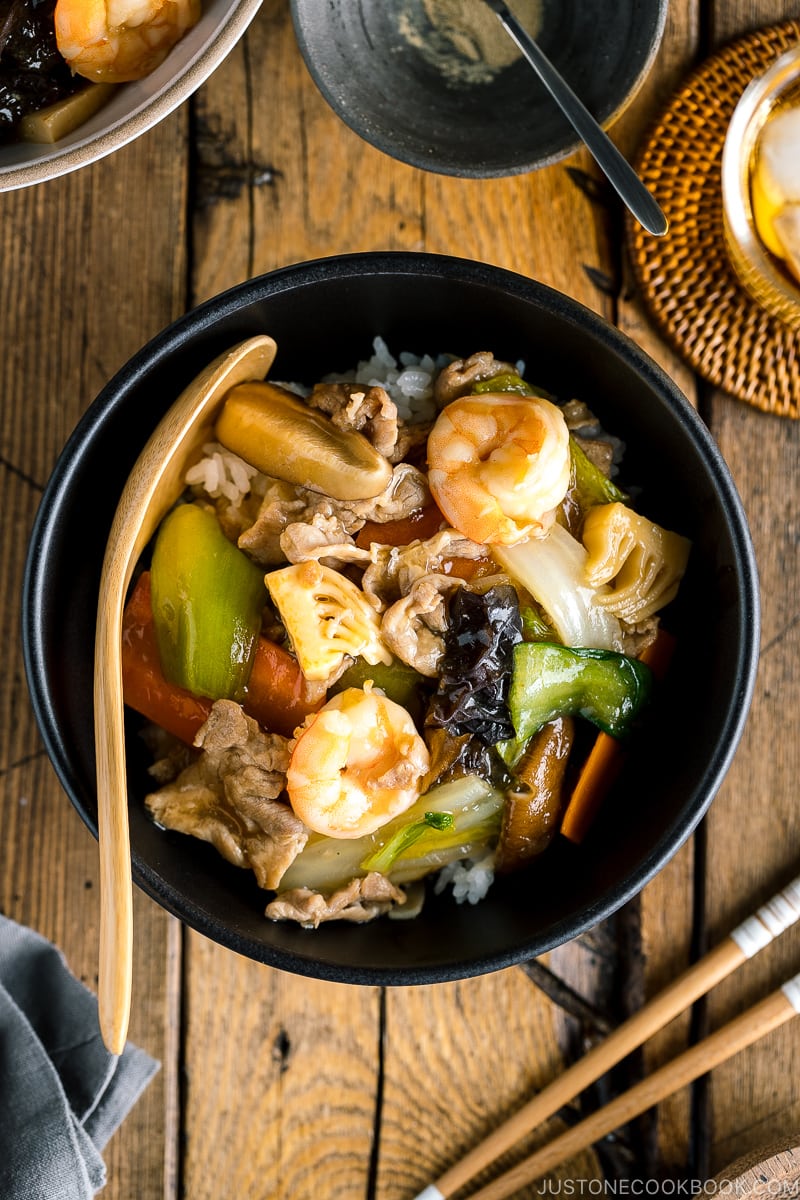
How to Make Chukadon
Basic Ingredients You’ll Need
- Pork
- Shrimp
- Carrot
- Napa cabbage
- Bok choy
- Shiitake mushroom
- Bamboo shoot
- Wood ear mushroom
- Condiments: chicken stock, soy sauce, oyster sauce, sake, sesame oil, potato starch (cornstarch)
- Steamed rice
Don’t have all the ingredients? Don’t worry, you can swap or leave out some of them. No napa cabbage? Use regular cabbage. Look in the fridge to see what works.
The only tip I have is that I do not recommend fragile leafy ingredients (like spinach) as stir-frying will cook them too fast and cannot withstand the heat for a longer time.
Quick Overview on Cooking Process
- Prepare ingredients – rehydrate, chop, and marinade.
- Stir fry pork and shrimp and set them aside.
- Stir fry dense vegetables and then leafy vegetables.
- Put back the pork and shrimp and toss them all together.
- Season the ingredients, add the slurry sauce, and give everything a good final toss!
Stir-Frying Tips
- Cut into similar shapes and sizes. This will cook the ingredients evenly.
- Heat the wok (or frying pan) till hot before adding ingredients.
- Don’t be shy with the oil. Add the oil after the wok/pan is heated, so the oil will be distributed easily.
- Stir fry ingredients in stages for best texture. Start with the proteins then set aside before you cook the vegetables. You’ll add in the proteins back later.
- Maintain high heat throughout cooking.
- Mix slurry sauce really well right before you drizzle.
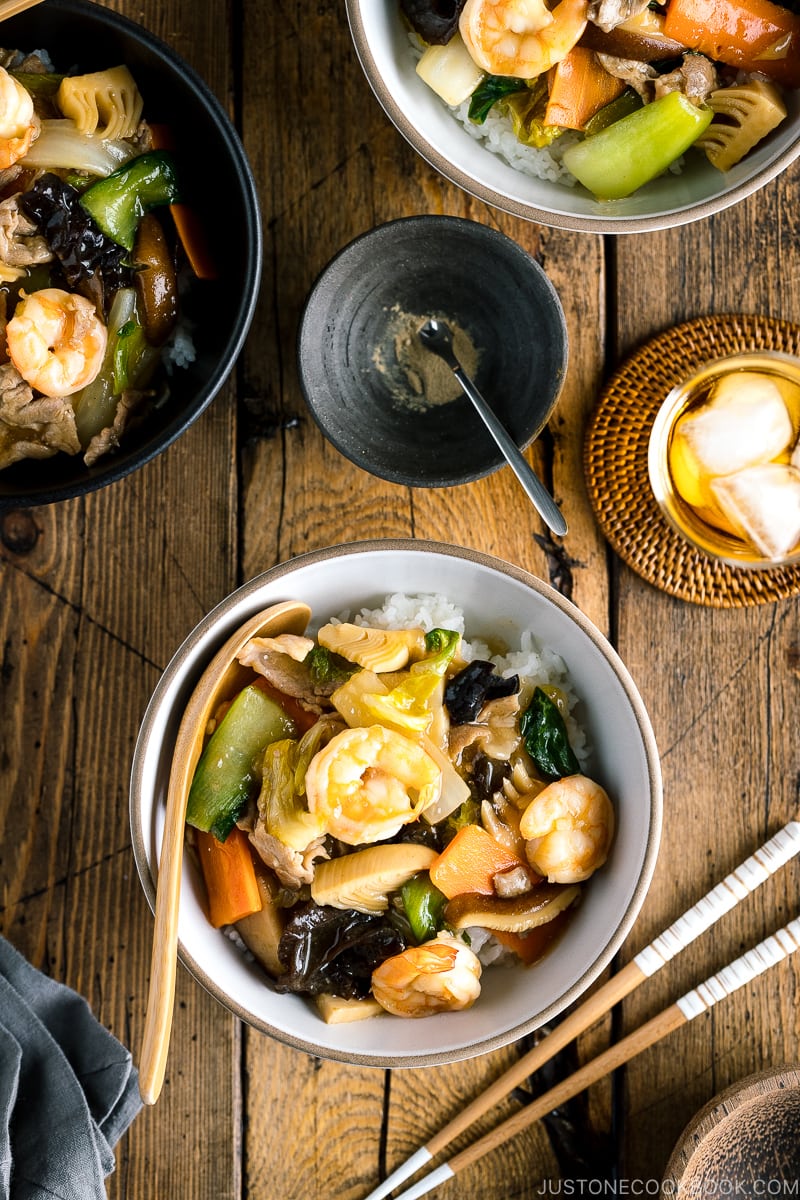
How to Serve Chukadon
Obviously this is a donburi (rice bowl) dish so we serve the medley of stir fry over a bowl of rice. The simple yet flavorful combo has everything you need!
However, if you want to serve it as a main dish without rice (the dish will be called Happosai), or a small portion as a side dish along with other Chinese-style dishes, you can definitely do that!
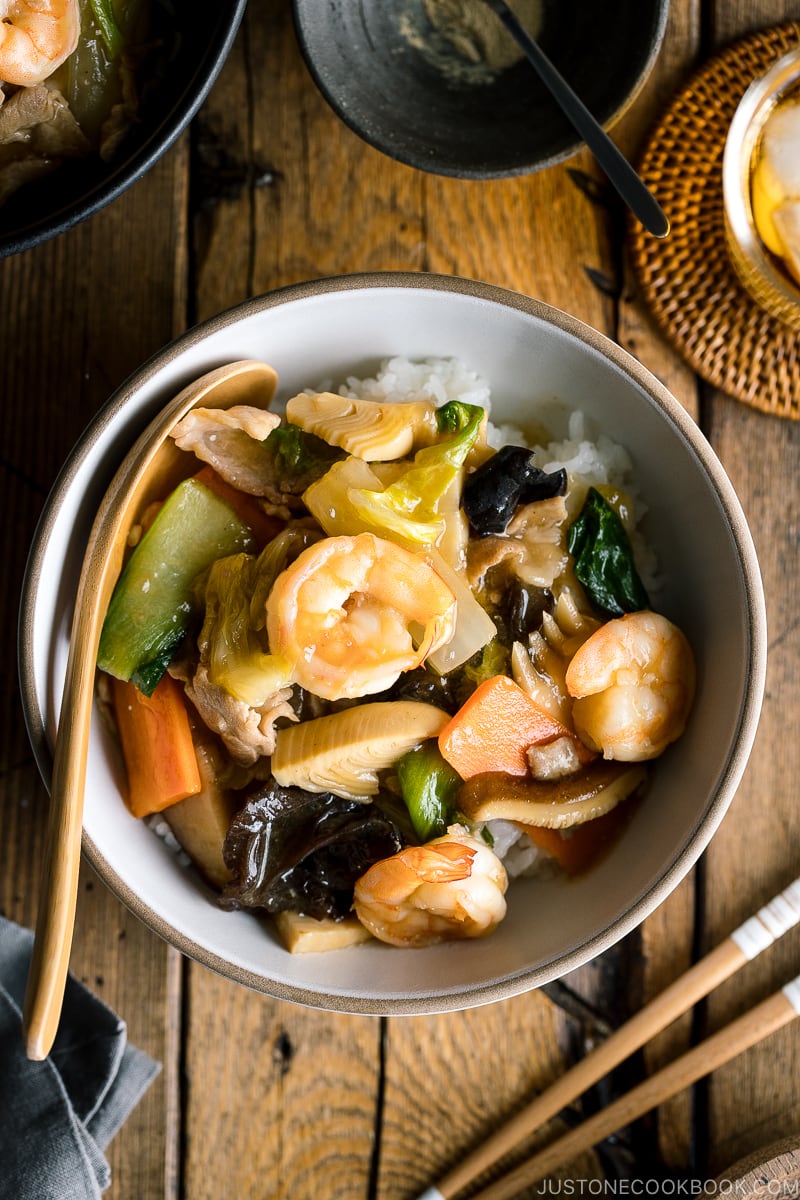
Other Chinese-Style Dishes You’ll Enjoy:
- Mapo Tofu
- Mapo Eggplants (Mabo Nasu)
- Beef & Green Pepper Stir Fry
- Sara Udon (Crispy Noodles with Seafood)
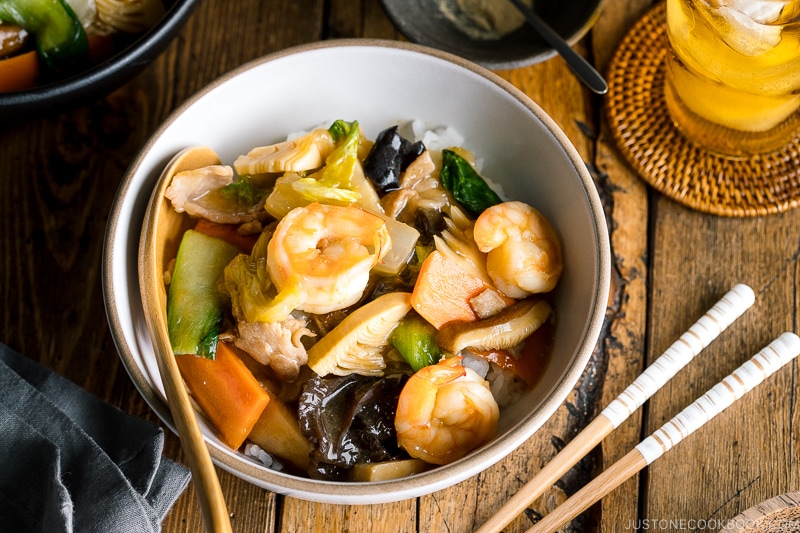
Wish to learn more about Japanese cooking? Sign up for our free newsletter to receive cooking tips & recipe updates! And stay in touch with me on Facebook, Pinterest, YouTube, and Instagram.
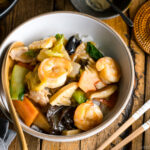
Chukadon (Chinese-Style Rice Bowl)
Ingredients
- 4 dried wood ear mushrooms (0.1 oz, 3 g)
- ½ carrot (3.5 oz, 100 g)
- 1 Shanghai bok choy (3.5 oz, 100 g)
- 2 leaves napa cabbage (6.6 oz, 188 g)
- ¼ piece boiled bamboo shoot (1.5 oz, 43 g)
- 1 shiitake mushroom (0.6 oz, 18 g)
For the Shrimp and Pork
- 6 oz sliced pork belly
- 6 shrimp (4.2 oz, 120 g)
- 1 Tbsp sake
- ¼ tsp Diamond Crystal kosher salt
- 2 tsp potato starch or cornstarch
For Stir-Frying
- 2 Tbsp neutral oil (divided; half for the pork and shrimp and half for the veggies)
For the Seasoning Sauce
- 1 cup chicken stock/broth
- ½ cup water
- ½ tsp sugar
- 1 Tbsp sake
- 1½ Tbsp soy sauce
- 1½ Tbsp oyster sauce
- ⅛ tsp white pepper powder (optional)
- 1 tsp toasted sesame oil
For the Slurry
- 2 Tbsp potato starch or cornstarch
- 2 Tbsp water
For Serving
- 3 servings cooked Japanese short-grain rice (typically 1⅔ cups (250 g) per donburi serving)
- white pepper powder (optional)
Instructions
- Before You Start: Gather all the ingredients. For the steamed rice, please note that 2¼ cups (450 g, 3 rice cooker cups) of uncooked Japanese short-grain rice yield 6⅔ cups (990 g) of cooked rice, enough for 3 donburi servings (5 cups, 750 g). See how to cook short-grain rice with a rice cooker, pot over the stove, Instant Pot, or donabe.
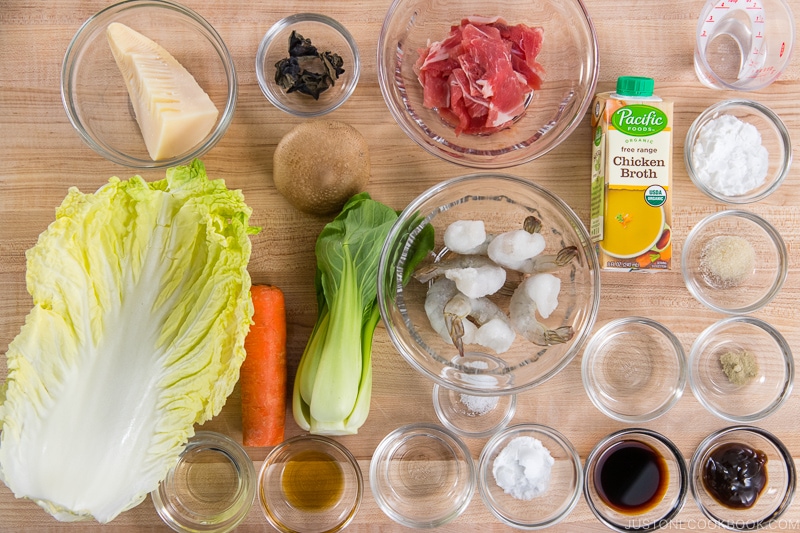
To Prepare the Vegetables
- In a small bowl, soak 4 dried wood ear mushrooms in water for 15 minutes to rehydrate, then cut them into smaller pieces. If you have time, soak them for 6 hours; they‘ll be close to fresh wood ear mushrooms.
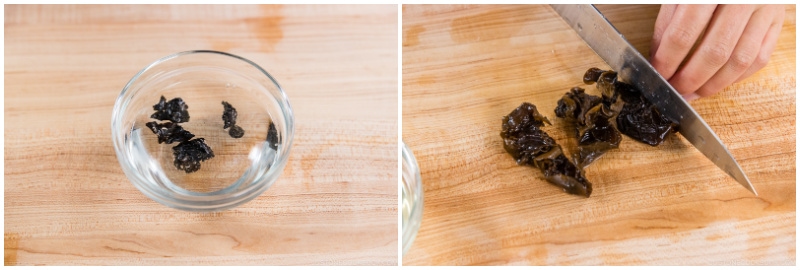
- Cut ½ carrot into 2-inch (5-cm) lengths and slice them into thin slabs. If any slabs are too wide, cut them in half to get bite-sized pieces.
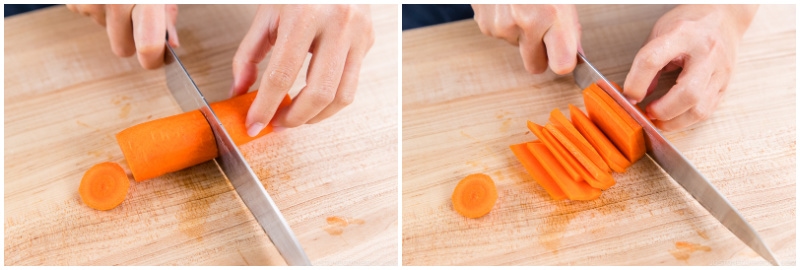
- Cut and discard the bottom end of 1 Shanghai bok choy. Then, cut it into 2-inch (5-cm) pieces. Wash the bok choy again if you find dirt between the layers. Keep the dense bottom and leafy pieces in two separate piles.
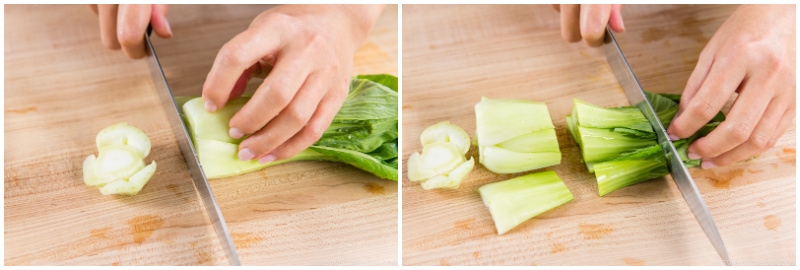
- Cut 2 leaves napa cabbage into 2-inch (5-cm) pieces widthwise. Then, cut them into bite-size pieces. Keep the dense bottom and leafy pieces in two separate piles.
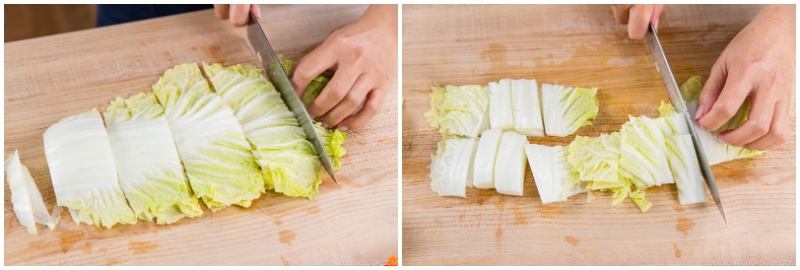
- Cut ¼ piece boiled bamboo shoot in half widthwise and cut into thin slices. The key to a great stir-fry is to have ingredients that are uniform in shape and thickness.

- Remove the stem of 1 shiitake mushroom and cut the cap into thin slices.
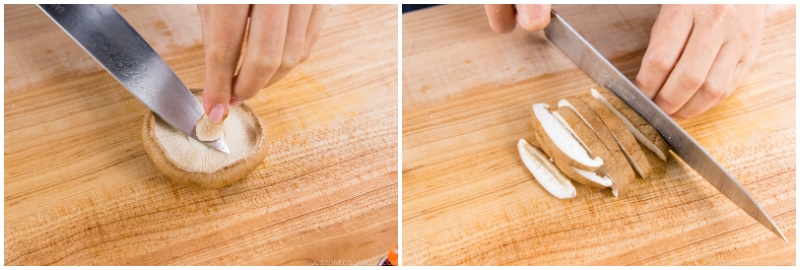
- Prepare all the ingredients on a tray/plate so it‘s easy to add them to the wok when you start stir-frying.
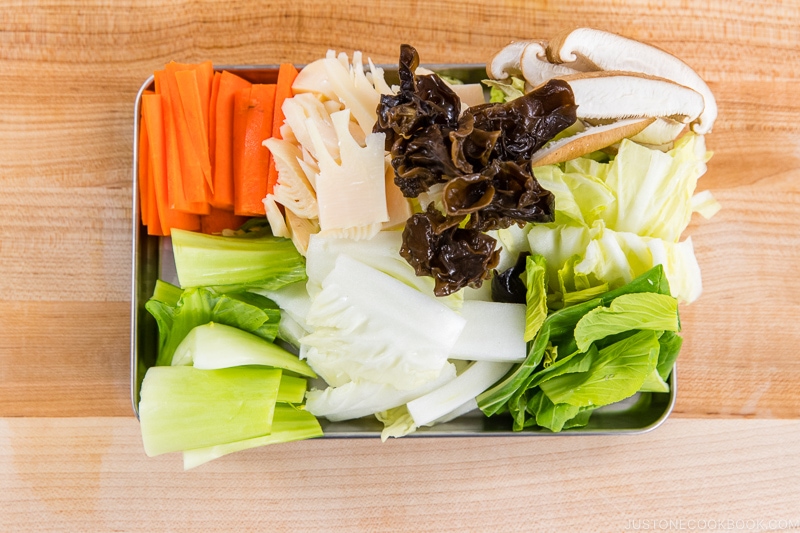
To Prepare the Shrimp and Pork
- Remove and discard the shells of 6 shrimp. Using a knife, cut along the outer edge of the shrimp’s back, about ¼-inch (6-mm) deep. If you can find it, remove and discard the vein that runs right under the surface. For step-by-step photos, see my post How to Devein Shrimp. If you can’t see the vein, don’t worry.
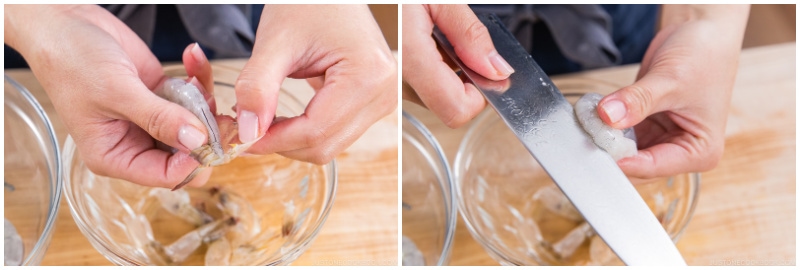
- In a medium bowl, add the deveined shrimp, 6 oz sliced pork belly, 1 Tbsp sake, ¼ tsp Diamond Crystal kosher salt, and 2 tsp potato starch or cornstarch. Rub the meat and shrimp with the seasonings.
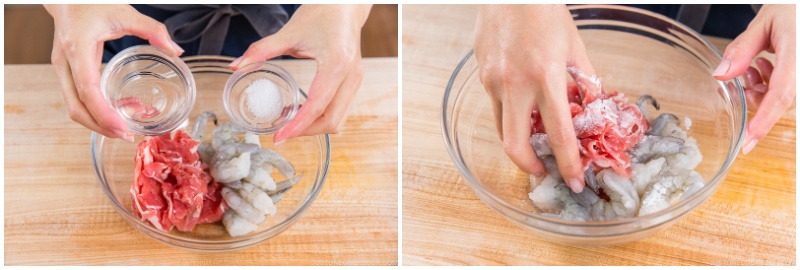
- In a small bowl, combine 2 Tbsp potato starch or cornstarch and 2 Tbsp water and mix well together. You will need to mix it again right before pouring.
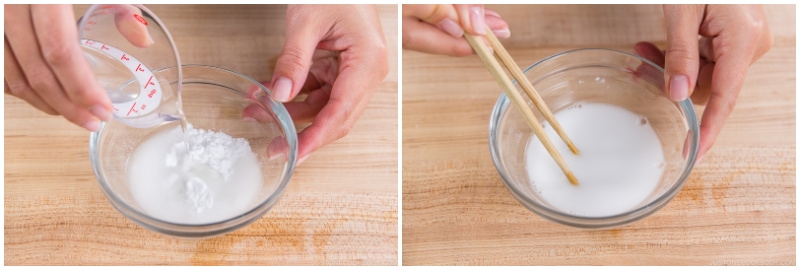
To Stir-Fry
- Heat the wok (or large frying pan) on medium high. When it’s hot, add 1 Tbsp oil and wait until the smoke starts to rise from the edge of the pan. Then, add the shrimp and pork to the wok.
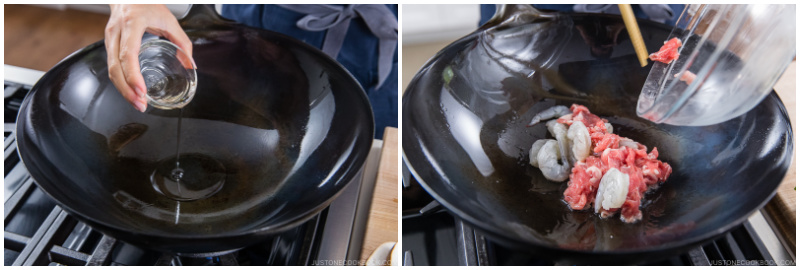
- Spread out the pork and shrimp so they have good contact with the hot wok surface. Cook until the pork is no longer pink and the shrimp changes color.
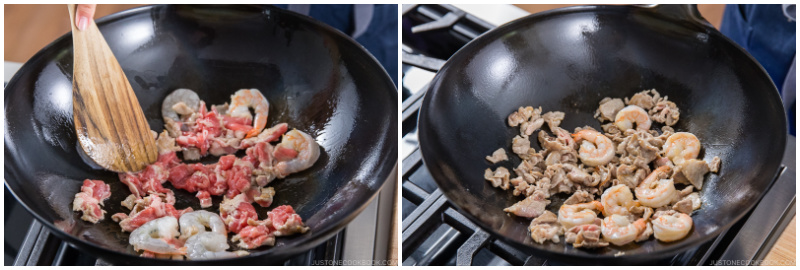
- Transfer the pork and shrimp to a plate. Next, add 1 Tbsp oil to the wok/pan and heat until hot.
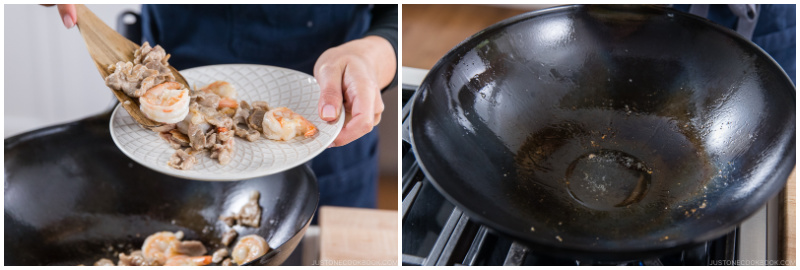
- Add the thick or dense vegetables—the sliced carrots, bamboo shoots, wood ear mushrooms, and bottom parts of the napa cabbage and bok choy. Stir-fry until 50% cooked through.
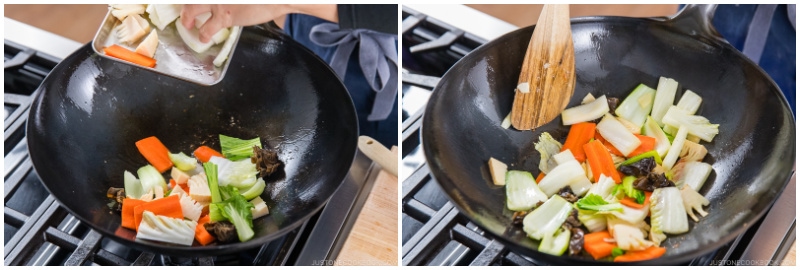
- Add the leafy vegetables and shiitake mushrooms. Quickly stir-fry, about 1–2 minutes.
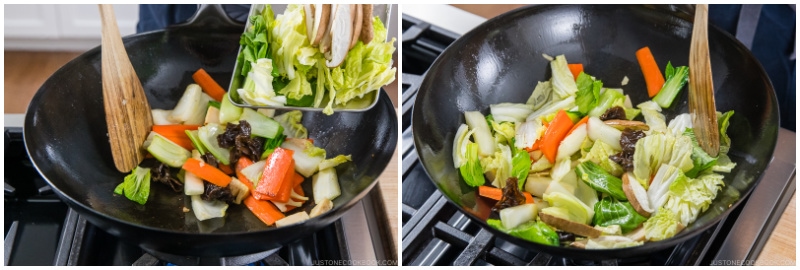
- Add 1 cup chicken stock/broth and ½ cup water to the hot wok.
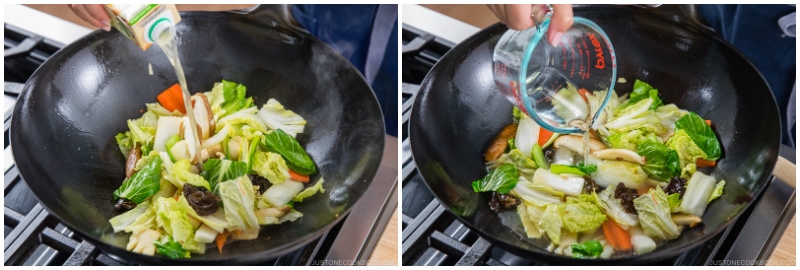
- Add ½ tsp sugar and 1 Tbsp sake and toss all together. Bring it back to a simmer and cook for 3–4 minutes.
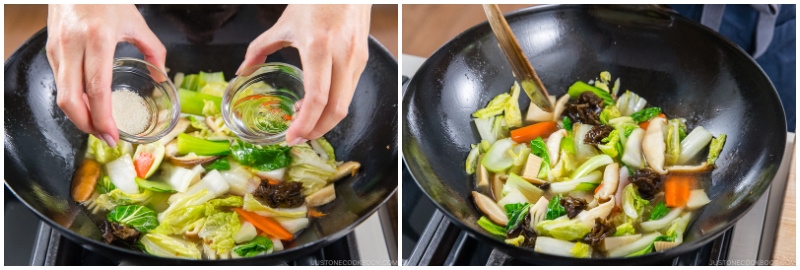
- When all the ingredients are nicely tender but still crisp, add the pork and shrimp back to the wok and toss them all together.
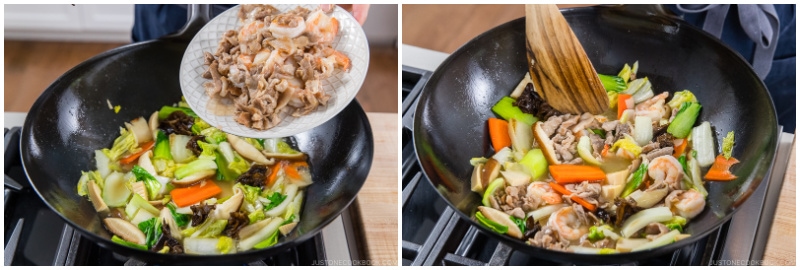
- Add 1½ Tbsp oyster sauce and 1½ Tbsp soy sauce and combine well with the ingredients.
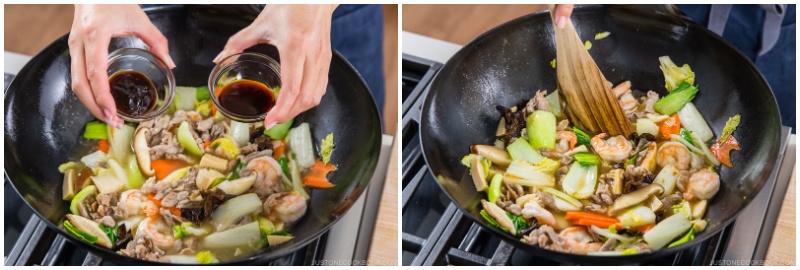
- Add ⅛ tsp white pepper powder and 1 tsp toasted sesame oil.
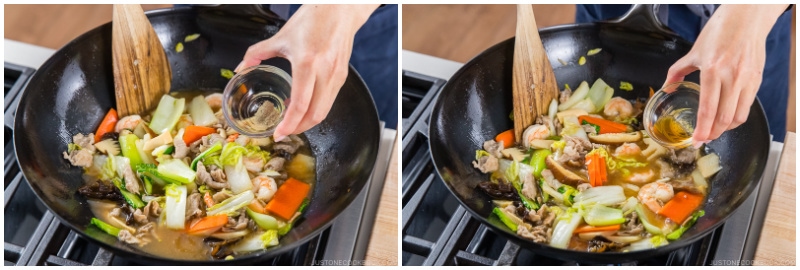
- Give the slurry another stir to loosen it up. With a fast motion, drizzle the slurry around the wok to evenly distribute it so it thickens evenly. Then, give everything a final toss together. Tip: If you feel the starch is too thick, you can add some water to loosen it up. The thickness of the sauce varies depending on how much cooking liquid has evaporated during the cooking process.
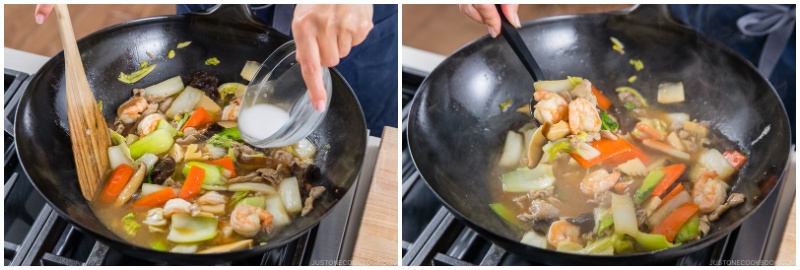
To Serve
- Divide the stir-fry over 3 servings cooked Japanese short-grain rice portioned into individual donburi (large) bowls. You can sprinkle white pepper powder if you like. Enjoy!
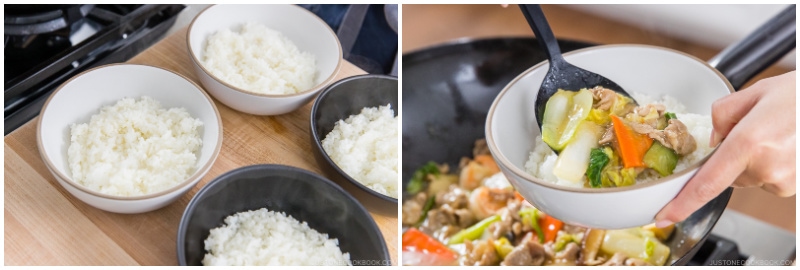
To Store
- You can keep the leftovers in an airtight container and store in the refrigerator for up to 3 days or in the freezer for a month.
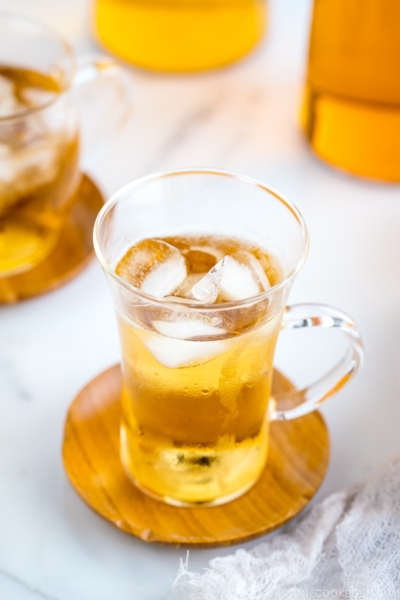
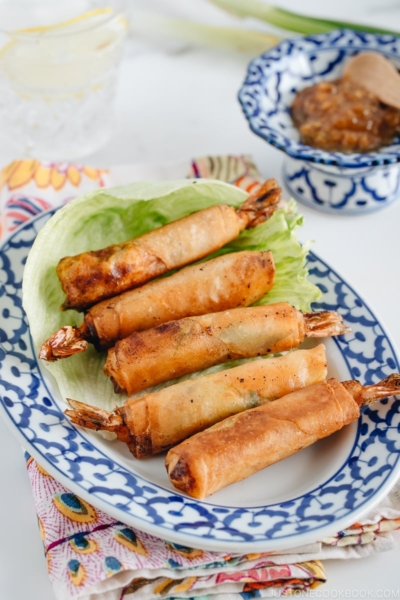
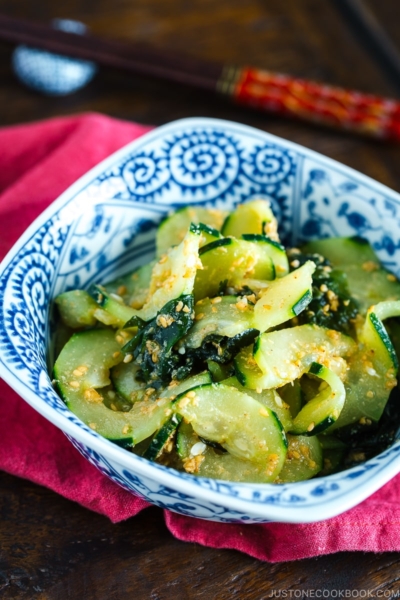
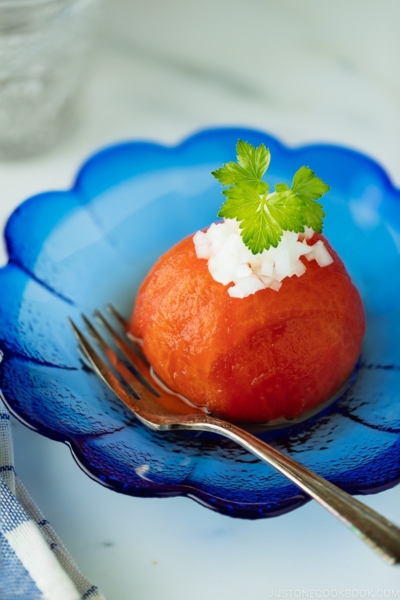




I made this with mirin instead of sake and dashi instead of chicken stock and green beans instead of bamboo 🙂 It was DELICIOUS. thank you Nami-san !!
Hi Fujiko! We are so happy to hear you enjoyed the dish!
Thank you for trying Nami’s recipe and sharing your experience with us. 🙂 Happy Cooking!
I don’t know how well this will go over with others but I love to add red yams (sweet potatoes) to Curry Rice. I have 14 Japanese cook books and I seldom consult them since I found your blog several years ago.
Hi Barbara! Thank you so much for your kind words. We are so happy to hear you enjoy Nami’s recipes!
Yes! Sweet potatoes will add sweetness to your curry while also tasting delicious. Happy Cooking!
I’m Nigerian & my wife is Japanese. On my cooking nights, the food was always hit & miss! But since I discovered your site, my wife praises my cooking constantly & can’t wait for my turn to cook. Unfortunately, Naomi san, I’m sorry to say that I haven’t let her know where the great recipes, brilliant instructions & videos I follow come from (yet). This Chukadon is a family favourite, I tend to use Pak Choi. Thanks you so much!
I made this the other evening, but substituted the pork and shrimp with chicken breast. Otherwise, we followed the recipe exactly, and it was absolutely delicious. My family loved it. We will definitely make this again. Thank you so much for all of your delicious and authentic recipes!
Hi Brenda! We are glad to hear the chicken breast worked well!
Thank you very much for trying Nami’s recipe and for your kind feedback.
My family loved this bc it was delicious. I loved it bc it was delicious and so easy to make! I mixed all of the wet ingredients together while prepping, only to see that your instructions had them added in parts; however, the dish still came together beautifully. This recipe is definitely a keeper! Thank you!
Hi Jane, We are so happy to hear you and your family enjoyed this dish!
Thank you very much for trying this recipe and for sharing your cooking experience and feedback with us.
I like all the recipes,thank you so much
Hi Juan! Thank you very much for trying many recipes and for your kind feedback!
Wow! Another amazing recipe. And so easy. Love the gravy flavor. We are gluten free and we’re able to find GF oyster sauce. And living next to an amazing Asian market means the wood ear mushrooms were fresh. We will be making this many times. Thank you, Namiko, for such wonderful Japanese recipes.
Hi Lauren, We are glad to hear you found GF oyster sauce and had a chance to enjoyed this dish! Easy access to many of the Asian items is a huge plus. You are fortunate! We hope you continue to try many recipes from our site. Thank you very much for trying Nami’s recipe and for your kind feedback!
Could this work without the shrimp/pork? Perhaps with more mushroom? Would you change the sauce for no meat/shrimp?
Hi TH, Sure, you can make this without the shrimp and pork. Adding more Shiitake mushroom to the dish will bring more Umami and is a good idea. You can also add fried tofu for more texture, and chicken broth can change to Dashi too. You can use the same for the sauce, but please adjust the amount for your liking. We hope this helps!
I did make this but used baby portabella mushrooms instead of the pork. I quartered the mushrooms and sauteed them until they released all their water, then splashed a little Bulldog Worcestershire sauce to add a deep meaty flavor to them. I set them aside and prepared the rest as best I could (it’s difficult to find fresh shiitake or wood ear mushroom here). It was delicious. So much so that the Hubs ate the leftovers for breakfast the next day.
Hi TH, Awesome! We are so happy to hear it turned out well.
Thank you for sharing your cooking experience with us!
*SORRY* I meant: “…for ‘non-Asian kitchen’ the ingredients for the sauce might be a stumbling block…”
Hi Llewellyn, Thank you very much for your feedback! We are glad to hear you love Nami’s detailed instructions!
These seasonings are common for Asian cooking, and we hope you have a chance to stock up in your kitchen to challenge many recipes from our site. Happy cooking!
I love your instructions. Awesome. Awesome. I like as much help as possible. And I don’t mind reading when pictures are included. We’re all children at heart and cooking. 4/5 because although you can substitute the veggies, the many non-Asian ingredients for the sauce might be a stumbling block to have to get in order to remain sincere to the recipe. But it’s worth it, especially sesame oil. Yummy.
Made this tonight and it was so delicious! I made sure there was lots of gravy and my husband loved it! Please keep posting these everyday home cooking recipes!
Hi Gryw, We are so happy to hear you and your husband enjoyed Homemade Chukadon! Thank you very much for trying this recipe!